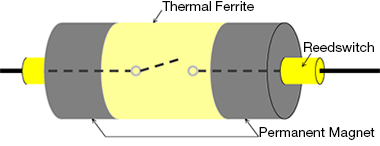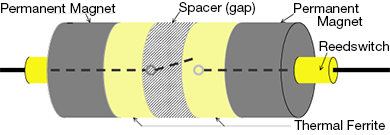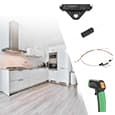About Competition | Blogging | Example Application | Resources | The Dates | The Prizes | The Kit | The Judges | Terms & Conditions | The Challengers | The Winners
Thermal switches (also called thermal sensors) are used in a variety of industrial, home/kitchen appliance, and HVAC products. They are typically used as protection against overheating, overcooling or overloads when used in a motor protection circuit. The most widely used thermal switches are bimetallic thermal switches and thermistors.
Bimetallic thermal switches consist of two strips of different metals that are bound together. Bimetallic thermal switches leverage the expansion of metals when they are heated. As the strip is heated, the different metals bend in different directions opening or closing a switch contact (NO/NC).
A thermistor is a type of resistor whose resistance changes with temperature changes. Thermistors are widely used as inrush current limiters, self-resetting overcurrent "fuses", and self-regulating heating elements.
The bimetallic thermal switches have been a mainstay for the design of thermostatic temperature controls and over-temperature protection over many decades. Thermistors have also been widely used, but neither type offers high accuracy or stability needed to meet the latest demands of consumers and industrial end users.
In response, thermal ferrite materials such as KEMET’s Thermorite® have emerged to enable a new generation of thermal switches (temperature sensors) that deliver greater accuracy, faster response times, and better stability with respect to ageing and environmental conditions such as humidity.
In this design challenge, participants will be given a kit of thermal switches based on KEMET’s Thermorite® to experiment with their use, application, response, and more.
| Thermal Switch/Sensor | Thermorite® Reed Switch | Bi-metallic Strips | Thermistors |
| ContactType | Mechanical | Mechanical | Electrical |
| Operating Principle | Switching the reed switch ON/OFF at a trigger temperature of the thermo-ferrite material | Switch ON/OFF at a trigger temperature by using two metal strips that have different thermal expansion coefficients which deform by temperature | Semiconductor (NTC) or Ceramic (PTC). Change in resistance due to temperature. |
What is Thermorite?
Thermorite is temperature sensitive ferromagnetic material that has soft magnetic characteristic under curie temperature. The material’s saturated magnetic flux density decreases as material temperature goes up, and it becomes paramagnetic (ferrite lose its magnetic property) rapidly when the temperature of the material reaches at curie temperature.
What is Curie Temperature? The Curie temperature is the temperature point above which some materials undergo an abrupt change such that they lose their permanent magnetic properties. The Curie temperature is synonymous to the Curie Point. It was named after scientist Pierre Curie who discovered the laws revolving around magnetic properties changing due to temperature changes.
Depending on its composition, Thermorite can be tuned to lose its magnetic permeability quickly at a predetermined temperature and instead behave as a paramagnetic material. KEMET’s TRS and OHD series of temperature sensors exploit this property to actuate a reed switch at a specific temperature determined by the composition of the thermosensitive ferrite. The switch can be designed either to open or close at this temperature.
How Does the Thermorite® Reed Switch Work?
The reed switch contains a pair of Fe-Ni (iron-nickel) reeds encased in a glass tube filled with inert gas. Encasing the reeds in this way ensures the switch is dust proof, explosion proof and corrosion resistant.
A Thermorite tube surrounds the reeds (Figure 1), and acts as a magnet at temperatures below the set point determined by the material composition. When the temperature rises above the set point, the Thermorite loses its magnetic properties and the magnetic field collapses allowing separated reed contacts to touch (make-type switch) or closed contacts to separate (break-type switch). The mechanism shows very little degradation due to metal fatigue. Tests under standard conditions have demonstrated switch lifetime based on metal fatigue of 500,000 on/off cycles.

Figure 1. Reed switch operating principle (Source: KEMET)
a) Break-type Switch
The break-type switch consists of the Thermorite® cylinder that surrounds the reeds. At both ends of the cylinder are ring-shaped permanent magnets, as shown in Figure 2.

Figure 2. Structure of break-type sensor (Source: KEMET)
Below the temperature set point, when the Thermorite acts as a magnetic material, the magnetic field acting on the reed is a single loop as if caused by one large surrounding magnet. This magnetic field induces opposing poles in the reeds, causing them to be attracted thus turning the switch "ON".
When the temperature set point is exceeded (i.e., curie temperature), the Thermorite loses its magnetic property. At this point the single magnetic field becomes two separate fields associated with the permanent magnets at each end of the switch, causing the contacts to separate. This turns the switch "OFF".
b) Make-type Switch
The make-type switch has a similar structure to the break-type, except for an additional spacer inserted in the middle of the Thermorite cylinder as shown in Figure 3.

Figure 3. Make-type switch structure(Source: KEMET)
When the surrounding temperature is lower than the temperature set point, the spacer causes the separated pairs of permanent magnet and Thermorite® to create two independent magnetic fields that act in a similar way to those of the break-type sensor in high-temperature mode. The contacts are separated and the switch is turned “OFF”.
When the temperature around the make-type switch rises above the set point, the Thermorite components lose their magnetism. The independent fields due to the permanent magnets closer to the ends of the reeds cause the contacts to join thus turning the switch “ON.” Table 2 summarises the switch states at temperatures above and below the set point defined by Thermorite composition.
| Switch Type | Status below temperature set point (Thermorite is magnetic) | Status above temperature set point (Thermorite is non-magnetic) |
| Make | OFF. Contacts open | ON. Contacts closed |
| Break | ON. Contacts closed. | OFF. Contacts open |
Table 2. Summary of switch status at temperatures above and below set point.
For more information about the Thermorite® Reed Switch, please vist the Resources section of this competition.
What kind of experiments can the participants perform with the Thermorite® Reed Switch?
Temperature control
- White Goods (Home kitchen appliances)
- Aquarium heater
Overheat Protection
- Industrial equipment
- IGBT module
- Motor and inverter drive
- Radiator, heating and fan control
But how you experiment with them depends are your interests and what stirs your curiosity about this relatively new product and how it functions.
What do I need to do to win the Grand Prize or Runner Up Prize?
After the month long enrollment period is completed, and the 15 FREE thermal switch component kits are shipped, you will have 8 weeks to complete your experiments, write two blogs, and share what you learned about Thermorite® Reed Switches. You will be judged by the quality of your final blog and what you learned about these components.
Can I still be elgibile for the Grand Prize or Runner Up Prizes if I am not selected for one of the 15 FREE kits?
Yes, on the condition that you obtain the Thermorite® Reed Switches featured in the kit and perform experiments with those components, and post your blogs in the Experimenting with Thermal Switches Group. You must write and post two blogs. Also, please notify rscasny@newark.com with links to your two blogs.
What do I get if I don't win the Grand Prize, but I wrote the two blogs?
If you write two blogs and post them in the Experimenting with Thermal Switches Group by the deadline on March 28, 2022, you have successfully completed your entry in the competition. If our judges do not select you for the Grand or Runner-Up prizes, you will be eligible to receive the finisher prize. But remember, you have to write two blogs by the deadline to be considered a finisher!
Resources
TRS Thermal Reed Switch, Screw Type
KEMET TRS Thermal Reed Switches - Tech Specs
Which Thermal Sensor to Choose?
Who is Eligible to Enroll in the Experimenting with Thermal Switches Competition?
Any element14 member can enroll in the Experimenting with Thermal Switches competition. But to receive one of 15 FREE magnetic component kits, you need to submit an application by the enrollment deadline, January 3rd, 2022. (If you're not an element14 member you will need create an account or register. It takes less than a minute to register.)
| Enrollment Begins: | December 3, 2021 |
| Enrollment Ends: | January 3, 2022 |
| Applicants Selected: | January 7, 2022 |
| Challenge Begins: | January 26, 2022 |
| Challenge Ends: | March 28, 2022 |
Blogging Requirements: Only 2 Blogs!
In order to successfully finish this competition, you are required to blog twice during the competition period. You can blog more than twice, if you wish. Our recommendation is:
Write Blog 1: Introduce yourself and explain what experiments you plan to perform. Due February 9th, 2022.
Write Blog 2: Show the results of your experiments, using images, screen captures, videos, tables, charts, etc. Then tell us what you learned about magnetic components. Due March 28, 2022.
Please also tag your blogs with 'Experimenting with Thermal Switches.'.
There will be two main prizes: a Grand Prize and a Runner Up prize. We will also offer a finisher prize to those who have met the requirements for finishing the competition in full but have not been chosen for the Grand and Runner Prizes. (Note: The Grand and Runner Up Prize winners will not receive a finisher prize.)
The Grand Prize will have two options:
| Option A | Option B |
|---|---|
|
DSOX1202A/DSOX1202A-100 ($1052) Digital Oscilloscope, InfiniiVision 1000 X-Series, 2 Analogue, 1 Ext Trigger, 100 MHz, 2 GSPS. |
Legion 5 Gen 6 AMD (17") with RTX 3050 Laptop ($1087) |
The Runner Up Winner will have two options:
| Option A | Option B |
|---|---|
|
SideTrak Axis Triple Portable Monitor for Laptop ($419) |
Apple iPad Mini ($499) |
The Finisher Prize is:

Multicomp Pro PDf Data Logger ($30.77 ea)
The Thermal Switches Experimenter’s Kit
element14 is offering for this competition 15 kits FREE of charge. To be eligible to receive one of them, you must submit an application by the enrollment deadline (January 3, 2022). Here is the kit (kit has been revised as of January 11th, 2022 due to availability of parts):
| Product Description | Buy Now |
|---|---|
| Thermostat Switch, Reed Switch, TRS Series, Axial, 30°C, Normally Closed, 100 Vdc, Molded | Buy Now |
| Switch, Thermal Reed, 0.5 Ohm, 120 Deg C, Break, Quick Connect, Screw Type | Buy Now |
| Thermostat Switch, Thermal Guard, OHD Series, Radial, 90°C, Normally Closed, 100 Vac/dc, 0.3A | Buy Now |
| Thermostat Switch, Thermal Guard, OHD Series, Axial, 30°C, Normally Closed, 100 Vac/dc, 0.3A | Buy Now |
| Thermostat Switch, Thermal Guard, OHD Series, Axial, 50°C, Normally Closed, 100 Vac/dc, 0.3A | Buy Now |
| Thermostat Switch, Thermal Guard, OHD Series, Axial, 90°C, Normally Open, 100 Vac/dc, 0.3A | Buy Now |
| Thermostat Switch, Reed Switch, TRS Series, Axial, 30°C, Normally Closed, Wire Harness, 100 V | Buy Now |
| Thermostat Switch, Thermal Guard, OHD Series, Radial, 105°C, Normally Closed, 100 Vac/dc, 0.3A | Buy Now |
| Thermostat Switch, Thermal Guard, OHD Series, Panel Mount, 115°C, Normally Open, 100 Vac/dc, 0.3A | Buy Now |
| Thermostat Switch, Reed Switch, TRS Series, Axial, 60°C, Normally Closed, 100 Vdc, Molded | Buy Now |
| Thermostat Switch, Thermal Guard, OHD Series, Axial, 110°C, Normally Open, 100 Vac/dc, 0.3A | Buy Now |
*Click buy now link to see product data sheet
Top Members of the element14 Community will be our judges. They are to be determined.
Top Member
Top Member shabaz
Shabaz has studied Electronics Engineering followed by Law, and worked primarily in the fields of radio communications (military), telecommunications (infrastructure used by phone companies), data networks, and information technology. He was originally involved in hardware design, followed by software engineering and technical marketing.
Thank you to our Judges for offering their time and service.
Tips on Writing Your Application
If you want to get a chance to received one of the 15 FREE Thermal Switches Kit, you will need to submit an application no later than January 3, 2022. The key to a winning application is to provide as much meaningful information about your proposed experiments as possible.
The application should be detailed enough to give the judges a good idea of what you plan to do and how you plan to pull it off. But you don’t have to write a book! By answering each of the following questions in your application, you will provide the judges with the information they need to make their decisions:
(a) Describe your technical background.
(b) Why are you interested in this competition? What interests you about thermal switches?
(c) What kind of experiment(s) do you plan to perform? (Be as specific as you can)
(d) Have you participated in the element14 Community? If so, please provide some links to what you've done. If you are a new member, answer "New Member."
All interested element14 members must submit an application before the end of enrollment on January 3, 2022.
Here are some other suggestions for completing a winning application:
1. Please complete all required information (contact information, etc.)
In the Project Title field, use "Experimenting with Thermal Switches" or your element14 member name. Please use the email address that is associated with your element14 profile.
2. Complete all of the application questions
Tell us why you want to be selected. Before deciding what you want to write, think about the following things:
- You are entering a competition. The most persuasive applications are the ones that attract the eye of the judges.
- A single sentence application will never be selected. This competition is not a game of chance.
- Be as detailed as possible, but don't write a book.
Anyone Can Participate in Experimenting with Thermal Switches
Any element14 member can enroll in the 'Experimenting with Thermal Switches’ competition. To receive one of the 15 FREE thermal switches kit, you need to submit an application by the deadline, January 3, 2022.
General Questions
For any general questions about the ‘Experimenting with Thermal Switches’ competition, please post a comment on this page.
To keep up-to-date with this competition, please bookmark it.







Top Comments
-

rsjawale24
-
Cancel
-
Vote Up
0
Vote Down
-
-
Sign in to reply
-
More
-
Cancel
Comment-

rsjawale24
-
Cancel
-
Vote Up
0
Vote Down
-
-
Sign in to reply
-
More
-
Cancel
Children